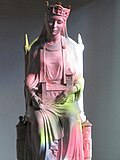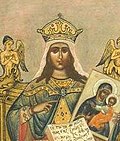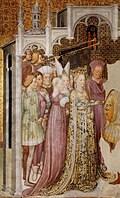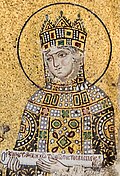List of 999 women of the Heritage Floor / Theodora I.
This list describes the place setting for Theodora I. on the table of the art installation The Dinner Party by Judy Chicago . It is part of the list of 999 women on the Heritage Floor who are assigned to the respective place settings on the table. The names of the 999 women are on the tiles of the Heritage Floor, which is arranged below the table and belongs to the art installation.
description
The installation consists of a three-sided table, each with 13 historical or mythological personalities, thus a total of 39 people, from prehistory to the women's rights movement . These people were assigned a place setting at the table, consisting of an individually designed table runner, an individually designed plate, a goblet, knife, fork, spoon and serviette. The first page of the table is devoted to prehistory up to the Roman Empire , the second to Christianization up to the Reformation and the third from the American Revolution to the women's movement. Each place setting on the table is assigned additional personalities who have received an entry on the tiles of the Heritage Floor, which occupies the space under the table and the center of the space between the sides of the table. This list includes the personalities who are assigned to Theodora I's place setting. Your seat is on the second side of the table.
Hints
In addition to the names as they are used in German transcription or in scientific usage, the list shows the spelling chosen by Judy Chicago on the tiles.
The information on women who do not yet have an article in the German-language Wikipedia is referenced by the individual references listed under comments . If individual information in the table is not referenced via the main article, additional individual references are given at the relevant point. If there are any discrepancies between the information provided in Wikipedia articles and the descriptions of the work of art on the Brooklyn Museum website , this will also be indicated under Comments.
Place setting for Theodora I.
Theodora I. was born around 500. Little is known about her early years, she is only mentioned by Prokop, and this more in the form of a diatribe. Later writings, on the other hand, almost transfigured Theodora into a saint, but these writings also mention that her youth was not immaculate. According to Prokop, her father was a bear keeper forthe Greens circus party . After his death, she worked as an actress, which in late antiquity can be understoodas a description for a prostitute .
Theodora came to Constantinople in 520 , previously she stayed in the Orient and North Africa. In Constantinople she met Petrus Sabbatius, who later became Emperor of the East under the name of Justinian . After a change in the law that allowed a Roman senator to marry an actress and the death of Empress Euphemias , wife of Emperor Justin , Justinian 's uncle, who had strongly opposed this connection, Theodora and Justinian married in 524/25.
Theodora was given the title of Augusta by Justinian in the summer of 527 and was given the same rank as the emperor during a court ceremony. Historically, she is considered a co-regent of Justinian. She actively supported the belief system of " Monophysitism ", which she might have gotten to know during her stay in the Orient. As a result, she was able to keep Justinian away from conflicts that developed out of this dispute. Her influence on Justinian in foreign policy was probably rather small, but she exercised her influence in personnel policy.
Justinian's laws against prostitution and trafficking in girls may have been initiated by her, and she was also a charity . She certainly had an influence on Justinian, but this probably did not go beyond what had been customary in the past. Coins with their image were not minted. She died on June 28, 548 in Constantinople.
Your place setting on the dinner party table features Byzantine icons and mosaics on the plate and table runner . They are intended to point out the role of Theodora in building the Byzantine Empire . The plate is painted with a mosaic, based on the mosaic of Theodora, with which the apse of the Basilica of San Vitale in Ravenna is designed. It adopts the color scheme gold, green and purple and also defines this for the table runner. The shape of the painting represents an abstract butterfly shape, with wings that extend to the edge of the plate. They are supposed to represent Theodora's ability to shape her role in the imperial house in Byzantium and thereby to obtain freedoms for the women of her time. The symmetry of the representation is reminiscent of the plan of a basilica with a colonnade of Roman arches in the upper quadrants of the wings.
The center of the table runner forms a mosaic, which was worked like a halo and is embroidered. The plate is placed in the middle of this mosaic. It represents the surrounding halo of the Ravenna mosaic and indicates the respect that Theodora enjoyed in religious terms in addition to her imperial rule. The initial letter "T" on the front of the runner indicates the Hagia Sophia through the dome that adorns it, which was rebuilt by Theodora and Justinian after it burned down. The back is decorated with fanned semicircles, which refer to the imperial collars, which were worn at the time of Theodora's reign.
| Surname | Spelling on the tile | Date of birth | cultural spatial assignment | Remarks | image |
|---|---|---|---|---|---|
| Adelheid of Burgundy | Adelaide | 931 or 932 | Holy Roman Empire | As the wife of Lothar of Italy from 947 to 950 Queen of Italy and as the wife of Otto the Great from 951 to 973 East Franconian Queen and again Queen of Italy and from 962 to 973 Empress of the East Franconian-German Empire . Canonized in 1097. |

|
| Aelia Eudocia | Eudocia | around 400 | Late antiquity , Athens | As the wife of the Eastern Roman Emperor Theodosius II , she was instrumental in building the Christian University of Constantinople , the so-called Athenaeum . |

|
| Aelia Eudoxia | Eudoxia | at 380 | Late antiquity , Constantinople | Sponsor of the Nicene Church through anti- Arian processions and the veneration of the relics of the martyrs . |

|
| Aelia Pulcheria | Pulcheria | 399 | Late antiquity , Constantinople | Daughter of Emperor Arcadius and Aelia Eudoxia , granddaughter of Emperor Theodosius I , was an Empress of the Eastern Roman Empire . |

|
| Æthelburg | Aethelburg | at 673 | Kingdom of Wessex | In 722 she destroyed the fortress of Taunton, which her husband Ine had built to find the rebel Ealdbert. | |
| Anna Dalassene | Anna Dalassena Comnena | 1025 | Byzantine Empire | Mother and active supporter of her son, the Byzantine emperor Alexios I Komnenos . | |
| Anna Komnena | Anna Comnena | 1083 | Byzantine Empire | Historian and the eldest of seven children of the Byzantine emperor Alexios I Komnenos and his wife Irene Dukaina . Wrote the Alexiad , which tells the political and military history of the Byzantine Empire under her father, Alexios I Comnenus. | |
| Bathilde | Balthilde | around 630 | Frankish Empire | Wife of the Franconian Merovingian king Clovis II of Neustria . She turned against slavery among Christians , passed laws against the enslavement of prisoners of war , founded the Chelles nunnery near Paris and the Corbie Abbey for monks. |

|
| Bertha | Bertha of England | at 565 | Kingdom of Kent | Queen of Kent, daughter of the Merovingian Frankish king Charibert I and the Ingoberga , saints whose influence led to the Christianization of Anglo-Saxon England. |

|
| Brunichild | Brunhilde | 543 | Frankish Empire | Queen of the Franks , daughter of the Visigoth king Athanagild and Queen Goswintha . After the murder of her husband Sigibert, she tried to preserve the Austrasia sub- kingdom for her children. |

|
| Chrodechild | Clotilda | 475 | Frankish Empire | Wife of Clovis I and through this marriage Queen of the Franks . As a holy Clothilde or Chlothilde she is venerated by the church. |

|
| Danielis | Damelis | 9th century BC Chr. | Ancient Greece | Widowed, wealthy Byzantine nobles from Patras. |

|
| Engelberga | Engleberga | 9th century | Frankish Empire , Italy | As the wife of Ludwig II , the Roman-German Emperor, she remained Empress on August 12, 875 after his death, although she only played a role in political life after the death of his father Lothar I in 855. | |
| Ethelfleda | Aethelflaed | at 872 | Mercia | Ruled this kingdom for eight years as Lady of Mercia . |

|
| Fredegunde | Fredegund | 6th century | Frankish Empire | Wife of the Merovingian King Chilperic I of Neustria and mother of the heir to the throne Chlothar II. Originally a maid, she became the third wife of Chilperich, killing his opponents, his previous wife and the sons from his first marriage in order to secure the throne for their children. |

|
| Irene | Irene | 752 | Byzantine Empire | Empress of the Byzantine Empire from 797 to 802. |
|
| Leoparda | Leoparda | 4th century | Late antiquity , Rome | Is mentioned by Theodorus Priscianus as a gynecologist. | |
| Mathilde | Maude | at 895 | Eastern Franconia , Quedlinburg Abbey | Wife of the East Franconian King Heinrich I from the Immedinger family , benefactress of the poor and founder of spiritual foundations. |

|
| Olga from Kiev | Olga | around 920 | Kievan Rus | Regent of the Kievan Rus. |

|
| Olympias of Constantinople | Olympia | at 368 | Late antiquity , Constantinople | Deaconess and Abbess . |

|
| Radegundis | Radegund | at 520 | Frankish Empire | Wife of the Frankish King Chlothar I and daughter of King Berthachar of Thuringia . She left her husband and founded the first monastery for women, the Sainte-Marie-hors-les-Murs monastery , later the Abbey of the Holy Cross in Poitiers. |

|
| Theodora II | Theodora II | around 805/807 | Byzantine Empire | Wife of the Byzantine emperor Theophilos and after his death regent of the Byzantine Empire . |

|
| Theodora III. | Theodora III | around 985 | Byzantine Empire | Empress of Byzantium . |

|
| Theudelinde | Theodelinda | around 570 | Lombards , Lombardy | Longobard queen venerated as a blessed . |

|
| Wanda | Wanda | N / A | Poland-Lithuania | Legendary figure, daughter (or granddaughter) of the Krakow Duke Krak . It is said to have ruled over the Poles around 700 , but threw itself into the Vistula to save Poland from further wars. The legend is one of the founding myths of the Polish aristocratic republic . |

|
| Zoe | Zoe | at 978 | Byzantine Empire | Byzantine Empress and daughter of Emperor Constantine VIII. |

|
- Individual evidence
- ^ Brooklyn Museum: Theodora. In: brooklynmuseum.org. Retrieved October 20, 2019 .
- ↑ Brooklyn Museum: leoparda. In: brooklynmuseum.org. Retrieved October 19, 2019 .
Web links
- Brooklyn Museum, Theodora
- The Dinner Party on the website of Through the Flower , Judy Chicago's non-profit organization
